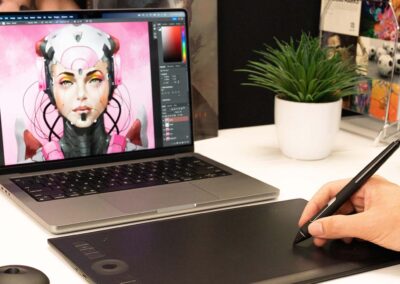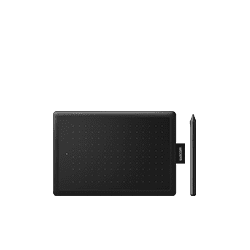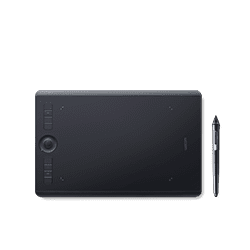This is the fifth in a series of interviews with hopefully, all eight artists who participated in the show we co-organized with Los Angeles’s Gallery Nucleus, then collaborated with each other to create the image below. (Some of them are taking longer than I expected to facilitate. At this rate, we might get into MerJuly.)

Previous ones: Tom Bancroft | Pernille Ørum | Brigitte Roka | Jenna Gray | Whitney Pollett
Neysa Bové

Her MerMay contribution, done on the Wacom One. From Instagram
Neysa Bové has known what she wanted to do from a very young age, and has been successful in doing it. Born in the micronation of Andorra on the Spanish border, she immigrated to the US with her family at the age of nine, bringing with her three Barbie dolls and a love of Disney movies.
Twenty years later, she found herself working for Mattel as a Barbie designer, and now, twenty-five years later, she’s a costume designer for Disney. Her credits include Frozen II, Ralph Breaks the Internet, and the movie she was most pivotal in, Moana, for which she designed the outfits and jewelry: I recommend this fantastic article by Tyranny of Style that explains the detail she went into to make sure that in addition to being unique, each piece of clothing could realistically be made using only materials naturally available in Polynesia.
Her personal work reflects the same influences but in a different way. As I learned during the interview, she uses primarily gouache, ink, and watercolors for her personal projects, which she draws in a style that’s like if 20th-century fashion illustration met naïve art—although the roughness and simplicity isn’t for lack of formal training: she’s an alumnus of the Fashion Institute of Design and Merchandising and has taken classes at Cal Arts (all hail).

Gouache painting from 2019. From Instagram.

Compare to this digital illustration from 2011. From The Neysa Bove Blog.
Also worth noting: She comes from a line of artists. Her father is a renowned abstract painter, and her sister, Lorelay, also works for Disney and is a an accomplished artist in a similar style—a dynamic also seen with Tom and Tony Bancroft.
This is the second interview I did with her: The first one was a very brief email exchange—from which I included a few excerpts—but I wanted to talk to her more thoroughly, so we spoke a few days later via Zoom.
—
How did you end up participating in Gallery Nucleus/Wacom’s MerMay project?
I’d done shows [with Gallery Nucleus] in the past, and Tom [Bancroft] just asked me to participate. And I obviously love mermaids, so I said, “Why not!”
You said via our email that you’ve loved them ever since you saw The Little Mermaid as a child in Spain. What impact did the movie have on you?
It was everything for me at that time. Even just being that little and being introduced to animation: We would watch Saturday morning cartoons like all the kids, but I have a memory of watching that for the first time and somehow seeing a different world. It didn’t feel like the Saturday morning cartoons—
It was next-level animation.
Right, and just seeing that and being transported into this world you never could’ve imagined was magical for me. It made you think of that world you didn’t think about before—the mermaid world—it was fantastical, and it just made you want to be part of it. No pun intended! [Laughs]
How long have you been participating in MerMay?
Not too long. I learned about it maybe two years ago. I was into it and thought it was fun, but the show was [what really got me to participate in it]. This one, and I’d done another one called Splish Splash that was based on mermaids as well—I don’t know if you’ve heard of it?
Yeah, Whitney Pollett mentioned she did that one.
She did. Pernielle too.
Speaking of Disney movies, you put an insane amount of effort into your work for Moana. Was that atypical of the amount of work a costume design project takes?
No, I would say a costume design involves several weeks if the production allows it. It’s based on schedule, and it’s based on, Is this an A character, is it a B character, or is it a crowd? And knowledge-wise, I would never claim to be an expert in a specific time period or a place, so you have to start learning from scratch in a lot of different situations. It’s a little crazy to take on the task of designing something while trying to become an expert when you know nothing.
Like in Moana, I knew nothing about Oceania in that time period. In these situations, what’s great about working at a studio is, you’re really lucky to be exposed to wonderful resources: Like bringing people from the actual islands to come talk to us and tell us about their experience, and tell us, “This is what my great-great-great grandmother would wear, and this color means this to us.” It would be really hard to do this on your own, so I appreciate that, and the fact that we’re allowed to be part of different cultures to tell their stories.
You mentioned in a previous interview that you’d also had an interest in Barbies from a young age: Was working for Mattel everything you hoped it would be?
With the way my career has been going… Since I was a kid, I always wanted to work at Disney, but I wasn’t sure in what capacity. Same thing with Barbie dolls. How fun would that be to be a toy designer? But being there and seeing it from a designer’s point of view versus growing up with Barbies—it’s pretty intense how you can affect a child’s life in a positive way. And it was cool to know a little girl, or a little boy, could be holding something you created, playing with it, being inspired by it—so I thought that was really great.
A lot of criticism has been directed at how dolls and princesses affect young girls’ self esteem, but what are the upsides of them?
It’s really interesting… Maybe it’s different now for the kids that are growing up with Instagram and TikTok and all these things, but remembering myself as a little girl playing with dolls, I never thought about their shape or anything like that—like, “Oh, she’s a skinny doll, I want to be like that!” I saw it from a different point of view.
But have you gotten much feedback from kids—or other adults—about how it affected them?
A lot of girls that have gotten into the fashion industry said they loved to dress up their Barbie dolls; they loved to use whatever fabrics they found in their house to make their own outfits. So that’s a fun way for a young child to be imaginative in their home, and to use a Barbie doll for that is pretty great for them.
There are a lot of similar stereotypes, and probably misconceptions, about the fashion industry as a whole, though. Are there any you’d like to clear up or correct?
Can you specify?
I suppose people discredit it as an art form, media often focuses on the craziest and least practical runway outfits, and there’s the body image controversy there as well.
To be frank with you, I think the fashion industry is a scary place. But I think it’s what you take from it, just like anything in life. There’s a dark side to everything. You hear about companies trying to do good, like [the ones] that try to get fabric resources from places that entrust women and they’re free to do that job, but not everything comes from that, so I think some of these stereotypes are true. I would never say they’re not. It’s a matter of educating yourself and knowing where you’re buying clothes from or what you’re getting inspired by—who’s making it. And with resources like the internet now, I think there’s no excuse. But at least for me, when I’m using fashion as an inspiration, I just try to look at editorial photography and things like that, so I still just try to look at what inspires me and not at the negative aspect of it, if that makes sense? I think it just matters what you do about it and what it means to you.
—
From email: What are your go-to reference sources for fashion? Do you have a giant folder on your computer, a collection of magazines, certain sites or blogs you default to?
I mainly use Pinterest; it’s a rabbit hole of inspiration. I have 30+ hidden boards of my inspiration- specific subcategories from current fashion runway shows, to 1960s fashion, to editorial fashion photography.

—
Do you have a favorite time period in clothing design?
I have a few favorites. I really love 16th, 17th century fashion, and the 1950s, 1960s time period; there was something really beautiful happening then. But they’re all very different, so when I try to do my own creations, I look at them and see what I can get inspired by, depending on the project.
What is it about 15 and 1600s fashion? The ornateness? The patterns?
Yeah! I think you hit the nail on the head there. It’s the ornateness and how meticulous they would be in that time period. Now you go to a store and just throw away clothes after wearing them for a few years, which I find really sad. But the way they would make things then was just ridiculous. Even garments that wouldn’t see the light of day, like the bloomers they would wear, they would add all this intricate embroidery. That’s interesting to me: how time-consuming it can be to make something that no one might even see. And even the way they would fasten these garments is really intricate.
This also relates to the 1950s and 1960s: If you pick up a garment from that time period, you can tell it was made to be worn for a long time. Even the effort they would put into making a button, or a buttonhole—there was just a quality they had back then.
Like Tom Bancroft, what’s it like having a sibling who’s also a successful artist? And you’ve both worked for Disney before, right?
We’re both working there right now. We’re working on the same movie!
Are you allowed to say what it is?
No. [Laughs] But we also worked together on a canceled project called Gigantic.
And you’re doing costume design?
Yes.
How about her? Is her work also related to costumes?
Lorelay does a little bit of everything. She focuses on environments and color—she’s a really great color designer, and she wants to do color scripts and things like that—but she’s very versatile and can definitely do characters.
Do you give each other feedback? What kind of things do you learn from each other?
Oh gosh, everything! [Laughs] Maybe I have an assignment and I will show it to her and say, “Hey, what do you think?” She’ll take a look and she’ll be very blunt with me, and tell me what’s working, what’s not working. It’s great to see it from a different point of view.
A lot of the time it’s hard because it’s definitely a thing where you have to set your ego aside: it’s not about that, it’s about the learning situation. And sometimes that’s hard to hear from your sibling because, you know, it’s your sibling. But at the same time, it’s really refreshing to get that clarity that you may not get from the rest of the team because maybe they don’t want to be so blunt.

Lorelay (L) and Neysa (R) at Disney’s Creative Campus. From Instagram
—
From email: Do you do much digital art in your personal time?
I love to do traditional art for my personal art since I save all digital for work… but I have found myself lately trying a few digital paintings for fun. I think at the end of the day, it’s lovely to have a tangible piece that feels more raw.
—
Are you more comfortable with traditional than digital?
No, I feel comfortable with both; the only difference is time. Time is not in my favor when I’m doing traditional painting, as an example, because if you make a mistake you have to fix it, where digitally, you can just edit, edit, edit, and you’re good.
I use traditional for my personal stuff because there’s a sense of freedom to use the time you need.
Traditional is limiting in some ways, though: For example, you don’t have an unlimited color palette. Is it more liberating in other ways?
Yeah! You want to know why? I always tell people this: There’s something about when you have an idea, you have a pen, and you sketch it, and it’s just raw. It just feels so connected, and it has the feeling of exactly what you want to convey. Whereas when you do that on the screen, you have the ability to edit or zoom into the screen really really tight, and I think it loses that. So sometimes, I end up looking at my original sketch and it may not be perfect, but it feels raw, and that’s something that I love to see in art.
Would you suggest that every digital artist have a background in traditional?
I think it would be good? [Laughs] Why wouldn’t you, right? Wouldn’t you want to feel what a real pastel feels like versus watercolors, and not just have it be the fake one on Photoshop? I would hope so!
Are you ever not dressed impeccably?

At Disneyland with her daughter. From Instagram.
[Laughs] I am not dressed impeccably half of the time, but thank you! I don’t know… I think it’s nice to feel good, and when you dress nice, you will bring your best self in certain situations—but especially right now in quarantine, I’ve been in some dark times, mentally, and that affects you. It’s a different time we’re living right now.
—
From email: Finally, how are you enjoying the Wacom One? Any notable features that have been useful to you as a digital painter?
It is so compact! I couldn’t get over the fact of how convenient it is. It’s portable! I can take it with me if I’m traveling, or just wanting to work from my garden. The screen size is perfect size, not too big, not too small. There’s no lag calibration-wise. I really do enjoy it. Oh! And I also enjoy the streamlined design; simple and aesthetically modern.
—
…Is there anything else you’d like to add to that?
It’s pretty straightforward. It doesn’t have all the bells and whistles, but I’m fine with that. I don’t get fussy with that stuff. I just want it simple. I want to be able to just draw and call it a day. I don’t need special zoom buttons or hotkeys on the side like you have with [some of the past Cintiqs]—I don’t really use those anyways.
And when you work in your garden with it, do you run it off your computer’s power?
Yeah, I plug it into a laptop so I can take it outside. It’s just nice to be outside ‘cause I’m in my room working all the time right now. It would be really hard to bring my whole Cintiq setup outside, but with the Wacom One, I can just take it, go out there, sit where I want, and it’s pretty nice!
—
The best overview of Neysa’s current work is her Instagram, @Neysabove. Her blog, which isn’t updated anymore but has several years of fascinating insight into her development as an artist, can be found here.
—
About the Interviewer
![]() CS Jones is a Philadelphia-based writer and illustrator. The former is best seen at thecsjones.com, and the latter at @thecsjones on Instagram. He’s back to using the avatar for this one, as he will in non-personal pieces, but that’s only because he likes it and put a lot of effort into it. (More than it may seem.)
CS Jones is a Philadelphia-based writer and illustrator. The former is best seen at thecsjones.com, and the latter at @thecsjones on Instagram. He’s back to using the avatar for this one, as he will in non-personal pieces, but that’s only because he likes it and put a lot of effort into it. (More than it may seem.)








